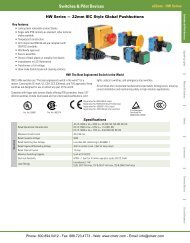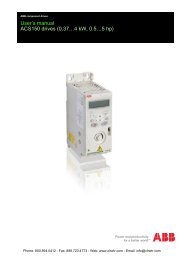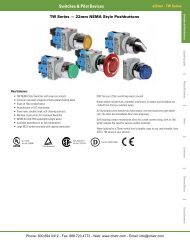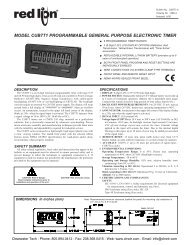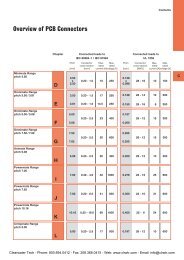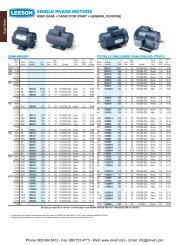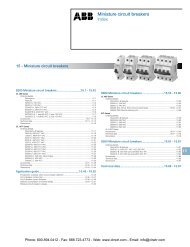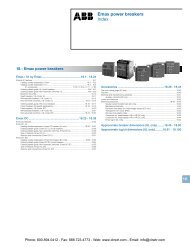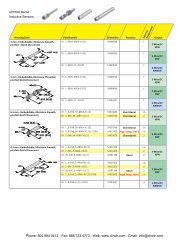IDEC / Datasensor Sensors - Clearwater Technologies, Inc.
IDEC / Datasensor Sensors - Clearwater Technologies, Inc.
IDEC / Datasensor Sensors - Clearwater Technologies, Inc.
Create successful ePaper yourself
Turn your PDF publications into a flip-book with our unique Google optimized e-Paper software.
General Information<br />
<strong>Sensors</strong><br />
Communication & Networking<br />
<strong>Sensors</strong><br />
Power Supplies<br />
Automation Software<br />
Operator Interfaces<br />
PLCs<br />
A slit attachment is available to modify the beam size of through-beam sensors.<br />
This option is recommended for detecting very small objects (near the size of the<br />
smallest object which a sensor can detect) or for eliminating light interference<br />
when sensors are mounted in close proximity.<br />
Retro-reflective<br />
Photoelectric sensors with this function contain both the emitter and<br />
receiver inside the same<br />
housing. The emitted<br />
light beam is reflected on the<br />
receiver due to a prismatic<br />
refl ector; an object is detected<br />
when it interrupts the beam.<br />
Compared to the through-beam<br />
optic function, the signal<br />
difference is reduced (when the<br />
light is freely reflected by the<br />
refl ector and when an object<br />
interrupts the beam) so Excess Gain is reduced and maximum operating<br />
distances can reach 12 meters. It is necessary to operate in clean environments<br />
without dirt or dust. A retro-refl ective sensor typically operates in the dark mode:<br />
output is activated when an object interrupts the light beam between the sensor<br />
and refl ector.<br />
When installing sensors which detect refl ected light, make sure that unwanted<br />
light refl ections from nearby surfaces, such as the fl oor, walls, refl ective machinery<br />
or stainless steel, do not reach the optical receiver.<br />
Also, make sure that reflected-light sensors mounted in close proximity do not<br />
cause interfering reflections. When it is not possible to maintain the recommended<br />
clearance between sensors, as noted in the individual installation sections,<br />
provide light barriers between sensors.<br />
Prismatic Reflector<br />
A prismatic reflector is able to refl ect incident light in a parallel manner, with a<br />
refl ection coefficient higher than any other object for angles less than 15°. Typically<br />
the operating distance proportionally increases according to the refl ector’s<br />
dimensions. The reflector can rotate the incident light’s polarization plane at 90°.<br />
Retro-refl ection<br />
with prismatic<br />
refl ector<br />
Retro-refl ection<br />
with fl at reflective<br />
surface<br />
Polarized Retro-reflective<br />
In presence of critical detection of objects with very refl ective surfaces,<br />
such as shiny metals or mirrored glass, retrorefl ex sensors with polarized<br />
filters have to be used. In polarized retrorefl ex sensors, the emission<br />
light is polarized on a vertical plane, while the reception is obtained only<br />
through a polarized filter on a horizontal plane. A prismatic refl ector rotates the<br />
light plane at a right angle, while the light refl ected from the object maintains<br />
polarization plane unvaried and is blocked by the fi lter placed on the receiver.<br />
Consequently, only the light refl ected by the prismatic refl ector is received.<br />
Retro-reflective for Transparent Objects<br />
For detection of transparent objects, such as PET bottles or Mylar<br />
sheets, a low-hysteresis retro-refl ective sensor (capable of detecting<br />
small signal differences) can be used. These sensors detect small<br />
signal differences that the light undergoes when it passes through a transparent<br />
object.<br />
Diffuse Proximity<br />
Photoelectric sensors with this function contain both the emitter and<br />
receiver inside the same housing. The emitted light beam is reflected<br />
on to the receiver directly by the object, which is detectedwithout the<br />
need of prismatic refl ectors. Proximity<br />
sensors represent the most economic<br />
and fastest mounting solution.<br />
However, they work with weaker<br />
signals compared to retro-refl ective<br />
sensors. Excess Gain is reduced and<br />
operating distance, depending on the<br />
object’s refl ection degree, can only<br />
reach 2 meters.<br />
A proximity sensor normally operates<br />
in light mode: the output is activated when an object enters the detection area<br />
and refl ects light emitted by the sensor.<br />
Background Suppression<br />
Background suppression sensors allow the operator to precisely set the<br />
maximum detection distance. The operating distance adjustment is not<br />
based upon the receiver’s<br />
sensitivity, but is obtained through<br />
optic triangulation, mechanically<br />
acting on the lenses or photoelements<br />
angle or electronically using PSD<br />
(Position-Sensitive Detectors)<br />
receiving systems. Consequently the<br />
detection of an object is independent<br />
of other objects behind (or in the<br />
background), which are suppressed.<br />
Moreover, due to this adjustment<br />
method, all objects can be detected at<br />
the same distance independent of<br />
their color.<br />
Distance <strong>Sensors</strong><br />
Distance sensors supply an analog signal of 0-10V or 4-20mA proportional<br />
to the measurement of the distance between the emitting optics<br />
and the target.<br />
The main technologies involved are optic triangulation and time-of-flight. The<br />
fi rst allows very precise measurements on short distances, while the second is<br />
ideal for medium and long distances.<br />
234 <strong>Clearwater</strong> Tech - Phone: 800.894.0412 - Fax: 208.368.0415 www.idec.com- Web: www.clrwtr.com - Email: info@clrwtr.com





